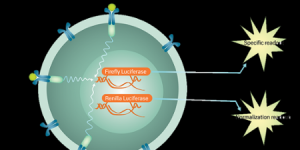| Gyros AB |

| No Title | 0.32 MB |
| Registration Date | 16 Aug 2018 |
| Revision Date | 16 Aug 2018 |
| Share |
Medicine Tissue Engineering
Human celliLite Type I IFN Assay Ready Cells can measure the bioactivity of Type I Interferon or can indirectly measures NAb’s to human Interferon beta or NAb’s to Interferon alpha. The cells are growth arrested cells which are sensitive to human Type I Interferon. The iLite IFN cells are the only commercially available cells capable of being used in a Reporter Gene Bioassay for either measuring Type I IFN or detecting neutralization of IFN beta activity or neutralization of IFN alpha activity.
iLite® Type I IFN Responsive cells are Type I IFN responsive reporter gene cells and can be used for measuring the bioactivity of Type I Interferon (IFN) or neutralizing antibodies (NAb’s) to Interferon beta or neutralizing antibodies to Interferon alpha.
The cell lines are engineered by use of target specific reporter gene constructs. Together with cells engineered not to respond to other factors that signal through the specific pathway, a specific and precise assay can be engineered. The read-out is light emission as measured by a standard luminometer.
iLite technology provides a seamless solution for applications extending across the whole drug development process, as well as for monitoring of biological drugs. The technology can be applied to many different drug targets and allows an easy, rapid and accurate test format for measurement and quantification of drug potency and immunogenicity. By combining unique features such as a normalization readout and chimeric transcription factors with a highly flexible product format, the iLite technology helps you make the most of your bioassay.
The technology is based on a dual reporter gene system. When a ligand binds to its receptor, its specific intracellular signaling pathway is activated, triggering the transcription of a specific reporter gene construct coding for Luciferase. The amount of luciferase and thereby the activity of the ligand can then be measured as light emission using a luminometer. The iLite cells also contain a second reporter gene which is under the control of a constitutive promoter, and is thus expressed continuously. This secondary readout can be used for normalization purposes, as it will correlate to the number of viable cells.